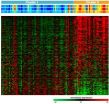(Press-News.org) ANN ARBOR—Reducing the size of the Lake Erie "dead zone" to acceptable levels will require cutting nutrient pollution nearly in half in coming decades, at a time when climate change is expected to make such reductions more difficult.
That's one of the main conclusions of a comprehensive new study that documents recent trends in Lake Erie's health. It offers science-based guidance to policymakers seeking to reduce the size of toxic algae blooms and oxygen-starved regions called hypoxic zones, or dead zones—two related water-quality problems that have seen a resurgence in the lake since the mid-1990s.
The report from the multi-institution EcoFore-Lake Erie project states that a 46 percent reduction in the amount, or load, of phosphorus pollution would be needed to shrink Lake Erie's Central Basin hypoxic zone to a size last seen in the mid-1990s—a time that coincided with the recovery of several recreational and commercial fisheries in the lake's west and central basins.
Phosphorus is a nutrient used in crop fertilizers. Excess phosphorus washes off croplands during rainstorms and flows downstream in rivers that feed the Great Lakes. Once in the lakes, phosphorus can trigger algae blooms. When the algae die and sink to the lake bottom, oxygen-consuming bacteria feed on them and create hypoxic zones in the process. Many fish shun these oxygen-starved waters, which significantly reduce the amount of suitable habitat available to the fish.
The study, accepted for publication in a forthcoming edition of the Journal of Great Lakes Research, calls for Central Basin phosphorus reductions considerably higher than other recent recommendations, including a proposal issued last year by the Ohio Lake Erie Phosphorus Task Force aimed at avoiding Western Basin toxic algae blooms. The new report is a synthesis of the major findings from the EcoFore-Lake Erie project, created in 2005 and supported by the U.S. National Oceanic and Atmospheric Administration's Center for Sponsored Coastal Ocean Research.
"The new target is very ambitious but is achievable if the region agrees to adopt agricultural practices that help reduce the amount of phosphorus-bearing fertilizer washing off fields," said aquatic ecologist Donald Scavia, director of the University of Michigan's Graham Sustainability Institute and EcoFore-Lake Erie principal investigator. "We believe this EcoFore synthesis report provides important input to the U.S. and Canadian teams charged with setting new phosphorus load targets for Lake Erie."
The EcoFore recommendations are aimed at policymakers who will update the binational Great Lakes Water Quality Agreement. A 2012 protocol amending the 1972 agreement commits the United States and Canada to revising phosphorus targets for open waters and near-shore areas of each Great Lake and taking actions to reduce phosphorus levels that contribute to harmful algae.
Lake Erie, once declared dead and then recovered, began showing signs of distress again in the mid-1990s, with large algae blooms and dead zones becoming more common. EcoFore-Lake Erie scientists created, tested and applied computer models to forecast how nutrient pollution and climate change are likely to influence the formation and growth of hypoxia in Lake Erie's largest basin, the Central Basin.
They also assessed the likely ecological impacts with an emphasis on fish production, because Central Basin hypoxia has a high potential to harm valued Lake Erie fisheries.
The researchers found that while the total amount of phosphorus washing into Lake Erie from several key watersheds (including the Maumee and Sandusky rivers) has been nearly constant since the mid-1990s, the percentage of a special type of phosphorus called dissolved reactive phosphorus, or DRP, more than doubled from 11 percent to 24 percent during that time.
"DRP is extremely bioavailable to algae, meaning the algae can readily absorb this nutrient and use it to fuel explosive growth," said EcoFore team member Joseph DePinto of LimnoTech in Ann Arbor.
Changes in farming practices in the region since the mid-1990s and an increased frequency of severe spring rainstorms likely worked together to boost the levels of DRP entering Lake Erie, according to the EcoFore researchers. Practices such as fall fertilizer broadcast application and no-till farming tend to leave lots of phosphorus in surface soils, where heavy rains can wash it away.
The observed precipitation trends are expected to continue in the coming decades. At the same time, Lake Erie's problems will be compounded by warming lake temperatures, the EcoFore scientists concluded. To explore various phosphorus-runoff scenarios, team members used previously published climate models that project spring precipitation increases in the region of 11 and 29 percent by the end of the century, along with summer temperature increases of 7.2 and 12.6 degrees Fahrenheit.
"Potential impacts of climate change need to be taken into consideration for effective action," said team member Nathan Bosch of Grace College in Winona Lake, Ind. "Most indications suggest that climate change will not only exacerbate existing problems but also make reducing phosphorus loads more difficult."
As Lake Erie warms, its fish will likely feel the squeeze from above and below.
"Climate warming can cause preferred habitat to be squeezed both from above by warmer temperatures and from below via increased hypoxia," said EcoFore team member Tomas Höök of Purdue University.
In fact, warming water temperatures "may have a stronger effect on fish habitat quality than nutrient loading," the EcoFore report states. "Under a warmer climate, we may need to reduce (phosphorus) loading levels even more dramatically to have meaningful positive effects on habitat quality and Lake Erie fish stocks."
The EcoFore team recommends that policymakers set separate targets for reducing both total phosphorus and DRP loading to Lake Erie. A 78 percent reduction in DRP annual load would be needed to reach a Central Basin hypoxia goal of 780 square miles. That's an area larger than Los Angeles and is roughly the size of the Central Basin dead zone that existed in the early 1990s.
Nutrient-reduction efforts, in the form of agricultural best management practices, should focus on the sites within watersheds that release the most phosphorus into rivers, according to the researchers.
"Importantly, while agricultural BMPs might be less effective under future climates, higher BMP implementation rates could still substantially offset anticipated increases in sediment and nutrient yields," Bosch said.
INFORMATION:
The report's U-M authors are from the Graham Sustainability Institute, School of Natural Resources and Environment, Cooperative Institute for Limnology and Ecosystems Research, Water Center and Department of Civil and Environmental Engineering.
In addition, the study's 28 authors include researchers at the Ohio Department of Natural Resources, Grace College, Ohio State University, LimnoTech, Purdue University, Heidelberg University, University of Wisconsin-Green Bay, University of Wisconsin-Madison, Korea Environment Institute, NOAA's Great Lakes Environmental Research Laboratory, the U.S. Geological Survey, Oregon State University, Cardno ENTRIX, and the Carnegie Institution for Science.
Funding for the project was provided by NOAA, the National Science Foundation and a Federal Aid in Sport Fish Restoration grant from the U.S. Fish and Wildlife Service and the Ohio Division of Wildlife. The title of the paper is "Assessing and addressing the re-eutrophication of Lake Erie: Central Basin Hypoxia."
Study and other information about the EcoFore-Lake Erie project: http://ecofore.org
Ambitious new pollution targets needed to protect Lake Erie from massive 'dead zone'
2014-02-26
ELSE PRESS RELEASES FROM THIS DATE:
UNC researchers team up to find new target for dengue virus vaccine
2014-02-26
CHAPEL HILL, NC – Creating a vaccine that protects people from all four types of dengue virus has frustrated scientists for decades. But researchers at the University of North Carolina have discovered a new target for human antibodies that could hold the key to a vaccine for the world's most widespread mosquito-borne disease.
Using an experimental technique new to the dengue field, the labs of Ralph Baric, PhD, and Aravinda de Silva, PhD, showed that a molecular hinge where two regions of a protein connect is where natural human antibodies attach to dengue 3 to disable ...
Research shows ovulation motivates women to outdo other women
2014-02-26
For approximately one week every month, millions of women change their economic behavior and become more focused on their social standing relative to other women. According to new research from The University of Texas at San Antonio (UTSA) and the University of Minnesota's Carlson School of Management, the ovulatory cycle alters women's behavior by subconsciously motivating them to outdo other women. This research could have important implications for marketers, consumers and researchers.
The researchers conducted three studies, one of which had ovulating and nonovulating ...
New advances in the chronic lymphocytic leukaemia genome
2014-02-26
This news release is available in Spanish. A study led by Dr. Roderic Guigó from the Centre for Genomic Regulation in Barcelona, as part of the Chronic Lymphatic Leukaemia Genome Consortium, has made new advances in the study of this disease. The work, which was published (in print version) last week in the journal Genome Research, scrutinised the functional profile of the genes and mutations associated with leukaemia.
The Spanish Chronic Lymphatic Leukaemia Genome Consortium had previously identified the principal mutations involved in the development of the disease. ...
Kessler Foundation researchers study factors affecting self-reporting among people with TBI
2014-02-26
West Orange, NJ. February 26, 2014. Kessler Foundation researchers have found that among individuals with TBI, depression and self-awareness affect subjective reports of memory, quality of life (QOL), and satisfaction with life. The study was published in the February 2014 issue of Brain Injury. (Yael Goverover, Nancy D. Chiaravalloti: The impact of self-awareness and depression on subjective reports of memory, quality- of-life and satisfaction with life following TBI. (doi:10.3109/02699052.2013.860474)
Impairment in self-awareness (the ability to accurately recognize ...
Nanoscale freezing leads to better imaging
2014-02-26
It's an odd twist. For scientists to determine if a cell is functioning properly, they must destroy it.
This is what happens in X-ray fluorescence microscopy when biological specimens are exposed to ionizing radiation, which provides images with a level of detail that conventional microscopes just can't match. This exposure can change what is being imaged in profound ways, possibly giving false accounts of how the cell actually works.
To address this issue, researchers at the U.S. Department of Energy's (DOE) Argonne National Laboratory created a new probe that freezes ...
Screen some patients with acute pancreatitis for pancreatic cancer, SLU researchers suggest
2014-02-26
ST. LOUIS – In a study published in Clinical Gastroenterology and Hepatology, Saint Louis University researchers have found a link between acute pancreatitis (inflammation of the pancreas) and pancreatic cancer, a finding which may eventually lead to some pancreatic cancers being detected earlier.
Principle investigator Banke Agarwal, M.D., associate professor of gastroenterology and hepatology at Saint Louis University, says the study builds on earlier research suggesting a connection between the two illnesses.
"Our study demonstrates that there is a much higher ...
Photopharmacology: Optoswitches turn pain off and sight on
2014-02-26
Photoreactive compounds developed by scientists of Ludwig-Maximilians-Universitaet (LMU) in Munich directly modulate nerve-cell function, and open new routes to the treatment of neurological diseases, including chronic pain and certain types of visual impairment.
All modes of sensory perception are based on communication between nerve cells. Both the response to the primary stimulus and the transmission of the resulting signal depend on the function of specialized receptor proteins that are associated with the surface membranes of neurons. Many sensory neurons respond ...
Researchers trap moths with plant-produced sex pheromone
2014-02-26
MANHATTAN, Kan. — A collaborative experiment involving a Kansas State University biochemist may mark the beginning of an effective, environmentally friendly plant-based method of insect control.
Timothy Durrett, assistant professor of biochemistry and molecular biophysics, was part of the collaboration that used various plant and moth enzymes to engineer plants that emitted sex pheromones that mimic those naturally produced by two species of moths.
The research recently appeared in the journal Nature Communications, "A plant factory for moth pheromone production." The ...
Uninsured parents don't take breastfeeding classes, even though breast is best
2014-02-26
ANN ARBOR, Mich. – Just 12 percent of parents without insurance coverage take breastfeeding support classes that can offer crucial support and encourage new moms to breastfeed, according to a new University of Michigan C.S. Mott Children's Hospital National Poll on Children's Health.
The American Academy of Pediatrics recommends exclusively breastfeeding until babies are 6 months of age followed by breastfeeding in combination with the introduction of complementary foods until at least 12 months of age. However, only about half of moms in the US are still breastfeeding ...
Finding a few foes among billions of cellular friends
2014-02-26
Beating cancer is all about early detection, and new research from the University of South Carolina is another step forward in catching the disease early. A team of chemists is reporting a new way to detect just a handful of lurking tumor cells, which can be outnumbered a billion to one in the bloodstream by healthy cells.
The researchers have constructed an ultrasensitive nanoprobe that can electrochemically sense as few as four circulating tumor cells, and it doesn't require any enzymes to produce a detectable signal.
"That makes it a very robust system," says Hui ...






